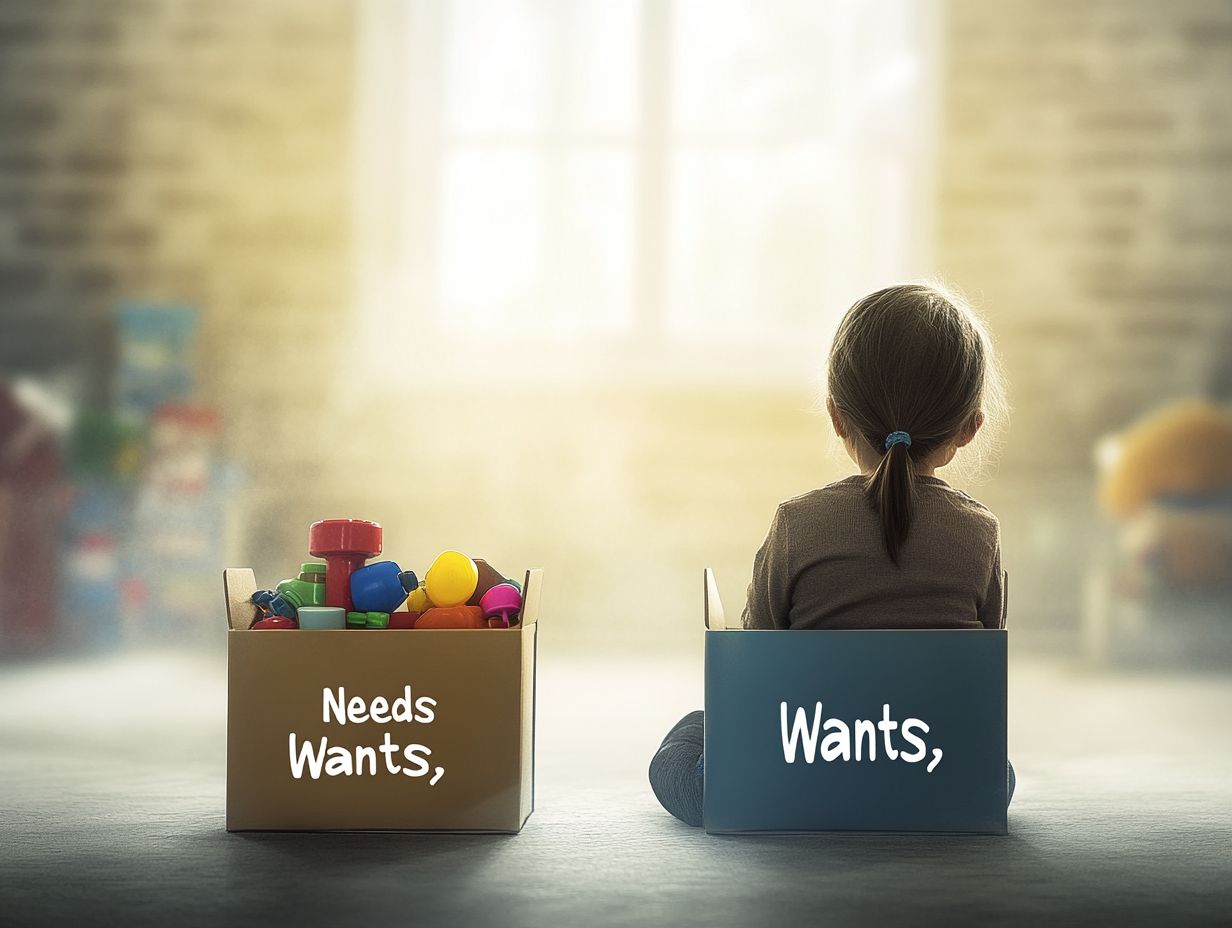How Can Children Understand the Difference Between Needs and Wants?

Neale Godfrey is the financial voice for women and multi-generations and a world-renowned speaker and author, who has inspired millions through her work. She motivates, trains, educates, and frankly, entertains by delivering her core message: Empower yourself to take control of your financial life.
Recognizing the difference between necessities and desires is an essential skill that greatly affects a child’s ability to understand money and make choices about it.
This article explores what needs and wants are, why it is important for children to learn this difference, and practical methods parents can use to teach these ideas.
From real-life examples to involving kids in budgeting, we provide practical tips to help children develop healthy spending habits.
Join us as we uncover the journey of financial understanding for the next generation.
Key Takeaways:
What are Needs and Wants?

Necessities and desires are important parts of human life, particularly in handling finances and making choices. Knowing the difference between these two ideas is important for everyone, especially children, as they consider their wants and needs in a marketplace centered on buying and selling.
Needs are essentials you must have to live and maintain a basic standard of life, such as food, housing, and education. Wants are items that make life more comfortable or enjoyable but are not necessary for survival, like luxury brands such as Nike or gadgets like an iPhone.
Understanding this distinction can significantly enhance one’s financial decision-making. According to a detailed explanation from Study.com, recognizing these differences is a critical component of economic literacy, which helps individuals prioritize their spending more effectively. For further exploration into children’s financial education, consider [introducing kids to investing concepts](https://breadbox.money/kids-finance-education-platform/interactive-learning/investing-kids-concepts-rewards/), which can provide practical insights into financial literacy.
Why is it Important for Children to Understand the Difference?
Children should learn to tell the difference between needs and wants because it helps them manage their money wisely and make careful decisions.
With so many ads around, kids often find it hard to know what is necessary and what is not, which can lead to careless spending. By teaching children these differences, parents can guide them to think critically and make sensible choices about how they use their money. Some leading researchers at Frontiers in Education emphasize the importance of financial literacy in shaping youth behavior and promoting wise spending habits. Worth exploring: Financial Literacy for Kids: Importance and Book Recommendations.
Learning this helps develop good money habits and a feeling of accountability in their community.
How Can Parents Teach Children about Needs and Wants?
Parents are important in teaching their children the difference between needs and wants, helping them learn how to handle money well.
Parents can teach these concepts well by setting a good example, using daily situations, and involving kids in budgeting. This practical approach teaches kids how to make good spending choices and see how their decisions impact society.
This guidance helps children develop good money habits as they grow into responsible adults. (For more insights on using apps to reinforce these concepts, explore our parental guide to Kiddie Kredit and Till apps).
1. Lead by Example
Leading by example is one of the most effective ways parents can teach their children about distinguishing between needs and wants while instilling financial responsibility. When parents demonstrate responsible spending habits, such as prioritizing essential items like school supplies over luxury items like Beanie Boos, they set a tangible standard for their children to follow. This approach lets children see and learn the importance of budgeting and choosing priorities through real-life examples, helping them see how their spending decisions affect their finances.
For instance, when planning a family outing, parents can opt for activities that are both affordable and enjoyable, like a picnic in the park instead of an expensive movie theater visit.
These choices teach children how to make cost-effective decisions and highlight the value of appreciating life’s basic joys.
Involving children in discussions about household budgets, like explaining why certain expenses are prioritized over others, reinforces the concept of financial planning.
Real-life examples teach kids good money habits, helping them understand how finances work and build a strong money sense as they grow.
2. Use Real-Life Examples
Using real-life examples is a strong way for parents to help children understand the ideas of needs and wants. When parents talk about everyday activities like buying groceries or choosing birthday presents, they can guide children in recognizing the differences and thinking about whether they really need certain things. For instance, explaining why an iPhone may be a want while a backpack for school is a need can clarify these concepts in practical terms.
Discussing budgeting can help people learn how to handle their finances better. For example, parents could sit down with their children and analyze a weekly grocery list, highlighting essential items like fruits and vegetables versus non-essential treats like snacks or sodas.
These questions might be like, ‘Is this item necessary, or should we save the money for something more meaningful?’ These discussions encourage children to learn how to make decisions suitable for their age about their spending.
When parents link these lessons to real-life situations, they help their children learn about financial priorities and guide them in making important decisions, getting them ready for money-related issues later in life. This aligns with insights from Charles Schwab, which offers practical tips on teaching kids about financial literacy effectively.
3. Get Children to Participate in Budgeting and Making Decisions

Teaching kids about budgeting and decision-making helps them learn to manage money and understand the difference between necessities and desires. By allowing children to participate in creating a family budget, they learn how to allocate resources wisely and make informed choices that align with their family’s values.
For example, discussing which school items are necessary and which ones can be postponed helps children understand prioritization and the importance of setting boundaries within their spending.
To improve this learning experience, parents can set up regular family meetings focused on money topics, allowing children to share their ideas and goals about spending.
Setting up a specific savings goal for a desired item, like a new toy or game, can motivate children and instill the value of delayed gratification. This team effort encourages open talks about money, helping young people feel in control of their choices with money.
This involvement helps students learn important skills like managing money, organizing plans, and being patient, which are needed for handling finances wisely when they are adults.
What are the Signs that a Child Understands the Difference?
Seeing the signs that a child knows the difference between needs and wants is important for parents to review their teaching methods and their child’s emotional awareness.
Children who can pick out basic needs, like food and clothing, while telling them apart from wants, like toys or luxury items, show a level of financial knowledge that can grow.
Kids who can wait for what they want and put their needs first demonstrate a deeper grasp of financial responsibility, which is key for their growth.
1. Can Identify Basic Needs
An obvious indication that a child knows the difference between needs and wants is when they can correctly recognize essential needs. This includes recognizing that essentials like food, shelter, and education are fundamental for survival, as opposed to wants which encompass luxury items or entertainment. For example, a child who understands that a backpack for school is a need but a toy is a want demonstrates an essential grasp of prioritization and the basics of financial responsibility.
To better assess what their child knows, parents can talk or do activities focused on identifying these ideas.
For instance, during a grocery shopping trip, they might ask the child to differentiate between items that are necessary for meals versus those that are just for fun, such as sweets and snacks. In the same way, parents can start conversations at home by asking questions like, ‘Why do we need a bed to sleep in?’ This type of talk helps the child understand the difference and also helps them grow emotionally by thinking critically and feeling for others who might not have basic things.
By including these learning moments in daily life, parents can greatly improve their child’s awareness of needs and wants.
2. Can Delay Gratification
The ability to wait for rewards shows that a child understands the difference between needs and wants. When children can wait to buy a wanted item, like a new toy, until after they have bought something they need, like school supplies, it shows they know how to prioritize and are responsible with money. This ability helps children learn about their feelings and make wise decisions about using their money.
Encouraging this ability can be achieved through various methods. For instance, parents might set up a reward system where children earn points for completing chores or homework, which they can later exchange for small treats or privileges. This creates a tangible connection between effort and reward, emphasizing the benefits of patience.
Parents can model delayed gratification in their own lives-such as saving for a family trip instead of impulsive purchases-demonstrating its long-term benefits.
Situations like saving for a coveted video game or waiting for a birthday to receive a special gift can further provide practical opportunities for practicing this essential skill.
3. Can Prioritize Needs over Wants
A child who can choose important needs over desires shows a good knowledge of handling money and using resources wisely. This skill is evident when children make conscious decisions, such as choosing to save for a necessary school item instead of spending their allowance on a toy. This prioritization reflects their emotional awareness and ability to assess their financial situations critically, which will serve them well throughout their lives.
In different daily situations, children can learn to tell the difference between what they need and what they want. For example, while buying groceries, they can talk about why some items, like healthy snacks, are important compared to sweet treats that are just for pleasure.
Parents can reinforce this teaching through practical tips, such as involving kids in budgeting for family outings or allowing them to make decisions about small purchases. Writing about their spending decisions can help with emotional growth, support self-reflection on their decisions, and help them learn the value of waiting for rewards.
When parents help children with these activities, they teach important skills for managing money and dealing with emotions effectively.
What happens if you don’t know the difference?

If children don’t learn to distinguish between needs and wants, they might have difficulty managing money later on.
Without knowing what’s important, they might have issues with managing their finances, buy things impulsively that aren’t necessary, and fail to handle their money well. To help combat this, understanding the importance of financial literacy for kids can be a crucial step.
This can lead to financial problems, stress, and challenges in achieving their goals as they grow up.
1. Financial Instability
A major result of not knowing the difference between needs and wants is the risk of financial trouble. When children fail to grasp this distinction, they may make impulsive decisions that prioritize non-essential items over critical needs. For example, spending money on luxury items like Nike shoes instead of saving for necessary school supplies can lead to financial challenges later in life.
Rushed choices can lead to habits that make it hard to save money for important things like tuition or a reliable car.
For instance, if an individual continually chooses to indulge in eating out rather than cooking at home, they might find themselves facing unexpected financial strain when emergencies arise.
Therefore, teaching money skills from a young age is important because it helps people understand their spending patterns and avoid unnecessary purchases, leading to lasting financial security and stability.
2. Impulsive Decision Making
Impulsive decisions are another concerning result of not knowing the difference between needs and wants, especially in children. When children make quick decisions and focus on getting things right away, like purchasing the newest Beanie Boo instead of saving for necessary items, they might form habits that weaken their ability to handle money responsibly and make sound choices. This pattern can lead to a series of bad decisions that harm their long-term finances.
For instance, a child may spend their allowance on a new toy rather than saving for a bicycle they desire, leading to disappointment and frustration when they realize the toy quickly loses its appeal.
Such short-sighted actions can cascade into adulthood, manifesting as credit card debt or failure to save for emergencies. By failing to distinguish between what they genuinely need and what they simply desire, children miss critical lessons in budgeting, saving, and delayed gratification.
These hasty choices can reduce their grasp of managing money and create a feeling of entitlement, which might make it harder for them to make good decisions later on.
3. Difficulty with Budgeting and Saving
Children who do not understand the difference between needs and wants often face difficulty with budgeting and saving, as they may lack the skills to allocate their resources effectively. This challenge can lead to ongoing financial struggles as they grow into adulthood, where the pressure to manage personal finances becomes increasingly critical. Not being able to tell the difference between what is necessary and what is a luxury can make it difficult for them to save money for important goals like education or emergencies.
Without a solid foundation in these essential skills, young adults may find themselves overwhelmed by debt and ill-prepared for unexpected expenses.
Parents play an important role in educating their children about money. By starting conversations about finances early, they can encourage open discussions.
Practical advice includes:
- Setting a budget together,
- Involving children in grocery shopping to highlight price differences,
- Encouraging them to save a portion of any allowance or gifts.
Utilizing tools like savings jars or apps designed for kids can make learning about budgeting both fun and effective.
These simple steps can greatly help a child learn about money and prepare them for a steady financial life.
How Can Parents Help Children Develop Healthy Spending Habits?
Parents can help children learn good spending habits that will benefit them throughout their lives. By setting limits on allowances, encouraging saving and donations, and discussing the value of money and effort, parents can build a solid foundation for financial responsibility and decision-making skills.
These actions show children how to handle their money carefully and teach lessons that will shape their financial decisions later on.
1. Set a Budget for Allowance

Setting a budget for allowances is an effective strategy that parents can use to teach children about financial responsibility and the importance of managing resources. By giving a set amount of money, parents can help children learn to spend wisely on both needs and wants, teaching them how to budget. For instance, if a child receives a monthly allowance, they can learn to save for a desired item while ensuring they cover essential expenses.
Implementing an allowance system can highlight the importance of prioritizing spending, as children begin to recognize the difference between essential items and luxuries.
Encouraging them to use budgeting methods like the envelope system, where they physically divide their money into categories, can improve this learning experience.
Explaining the ’50-30-20′ rule to them, which splits money into needs, wants, and savings, can help them grasp financial ideas better.
When parents discuss with their children the difference between saving money and spending it immediately, they help kids learn to make good decisions. This teaches them how to handle money well as they get older.
2. Encourage Saving and Giving
Teaching children to save and give money helps them develop good money habits later in life. Parents can promote saving by featuring savings goals, such as saving for a special toy or game, while also discussing the importance of giving to those in need within their community. This combined approach helps people learn and emphasizes the significance of money beyond just spending.
A useful approach is to open a savings account for the child. This way, they can see how close they are to their savings target and learn about banking and interest.
Alongside this, parents can engage their children in community service activities, allowing them to experience the joy of giving firsthand. Whether it’s giving toys, helping at local shelters, or raising money for charities, these activities can help them learn more about being generous with money.
Talking about the importance of budgeting and choosing needs over wants can help them understand financial responsibility and support emotional growth.
3. Discuss the Value of Money and Hard Work
Discussing the value of money and hard work is essential for parents to instill a strong sense of financial responsibility in their children. By explaining how hard work translates into earning money, parents can help children appreciate the effort required to obtain the items they desire. For example, engaging children in conversations about their parents’ work and its impact on the family budget can help them connect the dots between labor and financial rewards.
Parents can tell stories about their own money experiences, showing both achievements and errors, which can be useful lessons.
Including children in family money talks, like deciding on grocery spending or organizing a trip, gives them confidence and helps them learn about handling money practically.
Encouraging them to set savings goals for things they want can help them feel responsible and in control.
These methods teach kids how to handle money responsibly, ensuring they learn the importance of money and good work habits as they get older.
How Can Children Apply the Concept of Needs and Wants in Daily Life?
Kids can learn the difference between things they need and things they want by doing activities that teach them how to handle money. By identifying what is essential and what is extra, children can make informed choices about what they spend. Engaging in financial literacy activities designed for kids can further enhance their understanding, providing them with practical skills they can use in real-life scenarios.
This learning can take place during activities like grocery shopping with their parents or by looking at advertisements that sometimes blur these lines.
1. Making Decisions about Purchases
Deciding what to buy helps children learn the difference between necessities and desires in daily life. By evaluating whether an item, such as a new video game or a pair of shoes, is a need or a want, children can practice prioritization and budgeting skills. For instance, if they have a limited budget, they might decide that a new pair of school shoes is necessary, while a video game can wait.
To help guide them through this process, parents can introduce strategies that promote critical thinking and financial responsibility.
One effective method is creating pros and cons lists, which allow children to visualize the benefits and drawbacks of their potential purchases. This encourages them to consider factors such as longevity, utility, and emotional satisfaction.
Setting spending limits helps create clear boundaries for children to follow. By setting these limits, they learn how to handle money wisely and make good decisions, gaining knowledge about finances that will help them as adults.
2. Differentiating Between Needs and Wants in Advertisements
Learning to tell the difference between necessities and desires in ads is an important skill for children to learn as they grow up in a consumer-focused world. Children are often bombarded with marketing messages that can create confusion about what is truly essential. For instance, they might see an ad for new Nike shoes that highlights style over function, leading them to believe they need them rather than simply wanting them.
Parents can help children learn this important skill by talking with them about why they see different advertisements.
By asking open-ended questions about the products shown, such as who might benefit from them and how they align with their values, caregivers can encourage their children to think critically about marketing tactics.
Using practical exercises like budgeting games or shopping scenarios can improve their knowledge of managing money.
Teaching kids to tell the difference between needs and wants encourages thoughtful spending and helps them make good choices in a world with many buying options.
3. Knowing How Relationships Can Be Different
Knowing the difference between needs and wants is important for financial awareness and how children interact with others. When children learn to recognize what they need and desire, they can build better relationships with friends and family members. For example, realizing that emotional support and friendship are essential, while things you own are not, can help them develop empathy and relate better with others.
This awareness gives them important social abilities, helping them handle complicated emotions more successfully.
For instance, during a disagreement with friends, a child who understands that their need for respect is essential may approach conflict resolution with patience and openness. They may pay attention to their friend’s point of view, which helps develop emotional awareness and builds a positive team environment.
When a child realizes that their siblings ask for attention because they need support instead of just wanting toys, they can improve family relationships by being kind and supportive.
These situations demonstrate that recognizing differences makes a person better and helps create stronger bonds with others.

Neale Godfrey is the financial voice for women and multi-generations and a world-renowned speaker and author, who has inspired millions through her work. She motivates, trains, educates, and frankly, entertains by delivering her core message: Empower yourself to take control of your financial life.






